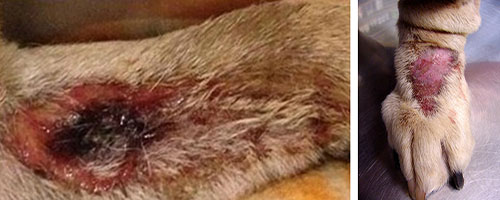Cutaneous and Renal Glomerular Vasculopathy (CRGV) is a rare, but often fatal disease that is affecting dogs in the UK. This disease is usually referred to as Alabama Rot by dog owners because it has similar clinical signs to a disease found in the USA that affected Greyhounds.
Although rare, this disease has been diagnosed or suspected in approximately 177 dogs since 2012. The main areas of infection were initially found in The New Forest, Surrey, Sussex, Hampshire and Dorset, but now the disease has also been seen in many other parts of the UK.
A 2018 study, using data from the Royal Veterinary College, included 101 CRGV cases and some 450,000 dogs under primary veterinary care in the UK. It’s key finding was that Gundogs, Hounds and Pastoral dogs were more likely to contract CRGV than other types of dogs, but it is unknown why this is the case.
What are the symptoms of CRGV?
CRGV targets the skin and kidneys and can affect any age, breed and sex of dog.
The initial clinical signs are lesions (sore, inflamed and/or ulcerated patches) on the skin which are usually on the lower legs and feet, but in some dogs have also been found on the tummy, muzzle and tongue. The lesions are usually 0.5cm – 5 cm in diameter. Within 1 – 9 days the dog may develop severe depression, loss of appetite, vomiting and kidney failure which can be fatal in about 80% of cases.
we recommend that if your dog is showing any of the clinical signs above, that you get in touch with your veterinary practice for advice as soon as possible.
Examples Of Skin Lesions

What is the treatment for CRGV?
Because the cause of the disease is currently unknown, the veterinary surgeon will treat the symptoms as they occur in the dog. This may include treatment for any skin lesions including bathing, dressing and medications as necessary, blood tests, urine tests, biopsies and, in cases where renal failure is diagnosed, the treatment may involve intravenous fluids and/or referral to a specialist veterinary practice in some cases.
Can CRGV be prevented?
It is very difficult to give advice regarding prevention because sadly the cause of this disease is currently unknown; however, we do know that the majority of dogs that have been diagnosed with the disease had been walked in muddy and/or woodland areas so it is advised that you wash any mud off your dog as soon as you get home after a walk. We also advise checking your dog’s body daily for lesions, sores or lumps (which we know most of you do anyway).
Researchers do not currently believe that this disease is passed from dog to dog and there is absolutely no evidence of it affecting humans or other animal species.
We are urging dog owners not to panic about the disease as it is very rare, but we would like you to be vigilant in checking your dogs for signs of this disease. It is important to remember that the vast majority of skin problems will just be regular skin problems and will not be caused by CRGV, but if you are in any doubt at all it is always best to seek veterinary advice because the sooner a problem is diagnosed the sooner it can be treated. If CRGV is diagnosed when it is in it’s earlier stages, there is a higher chance of the dog surviving.
Further information
CRGV is under investigation by the Anderson Moores Veterinary Specialists and a number of other organisations and more information can be found on their website.
Alabama Rot Confirmed Cases Map
How you can help
- Don’t panic about this disease – it is very rare and there is no reason to stop walking your dogs in their favourite places.
- Pass on the information about being vigilant and checking dogs for lesions to other pet owners.
If you are concerned about your dog’s health, please contact Castle Vets for an appointment on 0118 957 4488